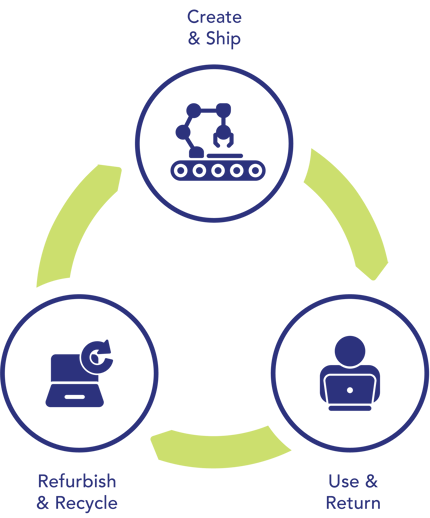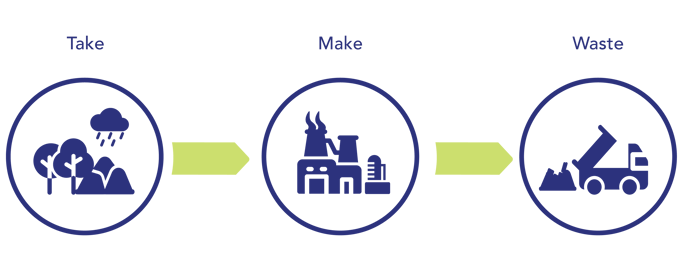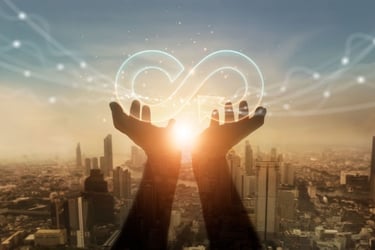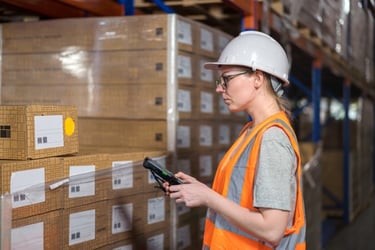Are you seeing the term ‘circular economy’ being used more, but aren’t sure what it entails?
Perhaps you bought a branded insulated coffee cup from a chain because it’s re-use friendly. Your mobile phone manufacturer or network operator has been advertising refurbished devices at a much lower price when compared to purchasing new ones.
These are examples of a circular economy in action. Reusable or preloved products replace those once intended to be used and then abandoned or destined for waste.
Ingram Micro Lifecycle’s mission is to enable a circular economy for our customers. We have worked with a variety of enterprises for over a decade in the provision of lifecycle extension services. We achieve this via services under reverse logistics and asset management.
In this piece, we explain the circular economy and how it differs from the linear approach to products we’ve gotten used to. We’ll also cover examples of how lifecycle extension services can recover value from your technology assets and boost your sustainability credentials.
What is a circular economy?
A circular economy takes a product that would become waste after one use and instead prolongs its lifecycle.
It retains value and use for longer, postponing the refresh point when a replacement is needed. This is the alternative to the common linear economy.
What is a linear economy?
The approach we’ve become accustomed to takes resources from the earth for manufacturing or energy, which ultimately end up as waste after their first use.
It’s incredibly wasteful when much of the materials could be recycled and reused.

The circular economy model

The linear economy model
How is a circular economy different?
A circular economy promotes reuse and recycling, extending the lifecycle of those materials and reducing the pressure to obtain more from natural sources.
The European Commission estimated that a circular economy could save the European Union around EUR600 billion. The concept applies to many industries, not just technology.
Do you keep plastic takeout containers and reuse them for your lunches or as leftover food storage? That would be circularity.
In a linear situation, you’d throw those plastic containers into your at-home recycling facilities after consuming the food.
The pressure on natural resources
Material reclamation poses a huge opportunity within e-waste in particular. The UN estimates that around 7% of gold mined from the earth is lying within e-waste, and that one tonne of e-waste contains 100 times more gold than one tonne of gold ore.
Precious metals are ten times more abundant in printed circuit boards than in their natural ores, and some technology uses up to 60 different periodic elements. If those end up in a linear economy, they go straight to landfills and are lost.
Not only is the end-of-life of products putting a strain on the environment, but the creation does too. The linear economy pressures manufacturing and natural resources to keep production swift and flowing.
Consumer demand increases manufacturing emitting more CO2 and other greenhouse gases as a by-product, reduces natural resources, and ultimately increases waste.
If we decreased the amount or frequency we bought new, manufacturing would decrease also. Those materials could go to use towards creating more sustainable goods or technologies.
For example, some of the materials used within smartphones are in renewable energy equipment. Fewer new smartphones = more renewable energy equipment.
What is e-waste?
E-waste is a discarded object that houses a battery or has a plug. This electronic waste is toxic or hazardous to the environment if left to decay and break down.
By 2030, 74 million tonnes of e-waste will have been produced globally - that’s equivalent to the weight of 7,326 Eiffel Towers.
Unfortunately, much of our technology has a short life, with many smartphones only averaging 2-3 years before they need repairs. Form and function push longevity and durability to the side.
Circular economy trends
There are eight common trends associated with enabling a circular economy, turning waste into materials for re-use.
- Blockchain – this verifies the sustainability of products, rewarding and compensating efforts towards circularity.
- Artificial Intelligence – AI sensors detect waste composition, including contaminants, to more efficiently process and sort.
- Bio-based materials – this is the creation of materials that can be composted or recycled, and typically used within packaging.
- Repair – when products are unfit for reuse, issues are fixed to restore working conditions.
- Remanufacture – the restoration of a product to its original condition, using a mix of previously used and new parts.
- Internet of waste – the development of smart waste collections to improve efficiencies.
- Reuse – once a product no longer has a use with its current owner or user, it’s passed to another rather than going to waste. Leasing programs are an example of this in action.
- Waste-to-resource – waste management companies harness the processing of waste to create energy. Waste can also be upcycled to produce new products.
Lifecycle extension
Specific services extend the lifespan of an electronic device. Repair and refurbishment restores the device to a better working condition, where economically possible.
There are three sustainable outcomes following lifecycle extension services.
Reuse
Once restored to good working order, the device is redeployed among your staff and returned to the field.
This saves you from the need to purchase new equipment every time you onboard someone new.
A previously used device is wiped and restored, ready to be used by the next person.
Resell
Rather than reusing a device you no longer need, sell it on the secondary market. This achieves a direct financial return for you.
Typical examples of this include traded-in smartphones. The original consumer no longer needs it, perhaps after upgrading to a newer model. You’ve purchased the device based on the current quality and condition of the handset.
After repair and refurbishment services, the grade is uplifted to recover maximum sales value.
Recycle
If a product is beyond economical repair and cannot be restored, it will be broken down into salvageable components. These will head for reuse in the restoration of other devices or recycling.
Any residual waste will be processed in compliance with e-waste regulations.
A technology circular economy in practice
Here are some examples of when lifecycle extension services can be put into place to recover value for you whilst enabling a circular economy and ensuring the longevity of your products.
Leasing and DaaS
Subscription models, such as leasing and DaaS (Device as a Service) support a circular economy because you’re only paying for a product while you have a want or need for it.
Returning the product to be re-used by someone else means it’s not going to waste. It gets repaired and refurbished to a usable condition and gives a new lease of life to the next user.
Often the companies leasing the goods provide in-contract support and repairs to ensure the life of the device is as long as it can be.
Refurbished products
The perception of refurbished and second-hand technology has vastly improved in the last few years. Goods are provided to a much higher standard as the technology and processes have rapidly.
The circular leasing model provides an alternative economic solution for those that may not be able to provide full payment for brand-new goods upfront.
Returns management
Customers return products for a variety of reasons. Perhaps they were dead on arrival, or user error caused issues.
Technicians with the ability to get under the skin of your product will be able to determine where the issue is if there is one. They’ll endeavor to fix technical problems, which will restore the product to fully functional use.
Once the product is working and like new, it can be resold on the secondary market. You don’t get returned stock depreciating or taking up warehousing space and instead can recover costs.
Ready to adopt a circular economy?
Shifting away from a linear economy towards a circular one ensures that the technology in use remains functional for as long as possible. This boosts our sustainability goals and is great for CSR/ESG.
Ingram Micro Lifecycle has the infrastructure and agility to enable enterprises to adopt a circular economy approach within their IT estate. We support three of the eight key trends of a circular economy; reuse, remanufacture, and repair.
Get in touch with us today to discuss your device usage and how we can recover value and save costs while making your company more sustainable.
Learn more about the circular economy
If this article has been of interest, then you may also like to read:








.jpg)




.jpeg?width=450&height=250&name=used%20computer%20hardware%20in%20garbage%20(1).jpeg)